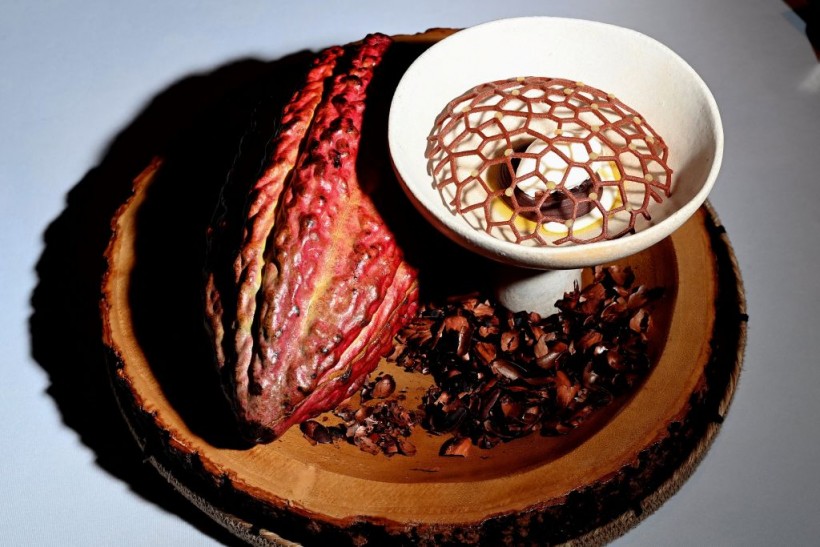Chocolate is one of the most popular and delicious treats in the world, but it also has a surprising potential to help fight global warming.
How? By using the waste product of chocolate production - cocoa shells - to create a substance called biochar, which can sequester carbon dioxide and enrich soils.
What is biochar and how does it work?
 (Photo : PETER PARKS/AFP via Getty Images)
(Photo : PETER PARKS/AFP via Getty Images)

Biochar is a black, porous material that is produced by heating organic matter, such as plant residues or animal manure, in a low-oxygen environment, as per Phys.org.
This process, known as pyrolysis, prevents the organic matter from decomposing and releasing carbon dioxide into the atmosphere.
Instead, the carbon is locked inside the biochar, which can then be used as a soil amendment or as an ingredient in green concrete.
Biochar has many benefits for the environment and agriculture. It can store carbon for centuries, reducing greenhouse gas emissions and mitigating climate change.
It can also improve soil fertility, water retention, nutrient cycling, and crop yields.
Moreover, it can reduce soil erosion, pollution, and greenhouse gas emissions from fertilizers and pesticides.
According to the United Nations' Intergovernmental Panel on Climate Change (IPCC), biochar could potentially be used to capture 2.6 billion of the 40 billion tonnes of CO2 currently produced by humanity each year.
How does chocolate fit into the picture?
Chocolate is made from cocoa beans, which are harvested from the pods of the cacao tree.
The beans are then fermented, dried, roasted, and shelled to produce cocoa nibs, which are ground into cocoa liquor, butter, and powder.
The shells, which make up about 12% of the cocoa bean weight, are usually discarded as waste or used as animal feed or mulch.
However, some innovative companies have found a way to turn cocoa shells into biochar.
One of them is Circular Carbon, a German start-up that operates one of the largest biochar plants in Europe.
The plant receives cocoa shells from a neighboring chocolate factory via a network of pipes and converts them into biochar using pyrolysis.
The biochar is then sold to local farmers or used to make green concrete.
Circular Carbon's CEO Peik Stenlund says that his company is "reversing the carbon cycle" by transforming cocoa shells into biochar.
One tonne of biochar can store the equivalent of 2.5 to three tonnes of CO2. The company also produces biogas from the pyrolysis process, which is resold to the chocolate factory.
Circular Carbon is not alone in harnessing the power of cocoa shells.
In Ghana, the world's second-largest cocoa producer, a company called Biochar Farms is working with smallholder farmers to produce biochar from cocoa pods and other agricultural waste.
The biochar is then used to enhance soil quality and increase crop yields on degraded lands.
Also Read: Dark Chocolate Improves Brain Function
What are the challenges and opportunities?
While biochar offers a promising solution to combat climate change and boost food security, it also faces some challenges and limitations.
One of them is scaling up its production and use to make a significant impact on global carbon emissions. This would require more research, investment, infrastructure, and policy support.
Another challenge is ensuring that biochar production does not compete with food production or cause deforestation.
Biochar should be made from sustainable sources of biomass that do not affect food security or biodiversity.
Cocoa shells are an ideal feedstock for biochar because they are abundant, renewable, and have no other use.
However, cocoa production itself is threatened by climate change, as rising temperatures and changing rainfall patterns affect the growth and yield of cacao trees.
Cacao trees are sensitive to heat and drought and require specific climatic conditions to thrive.
According to a study by the International Center for Tropical Agriculture (CIAT), cacao production could decline by up to 50% by 2050 due to climate change.
Therefore, biochar alone cannot save chocolate from disappearing.
Other adaptation strategies are needed to help cacao farmers cope with climate change, such as developing drought-resistant varieties, diversifying crops, improving shade management, and enhancing access to markets and information.
Biochar could be part of a holistic approach to make chocolate production more sustainable and resilient in the face of climate change.
By using cocoa shells as a source of biochar, chocolate lovers could enjoy their favorite treat while also contributing to a greener and healthier planet.
Related article: Climate Change Aggravates Food Shortage Across the Globe, Affects Chocolate, Coffee, Chili
© 2024 NatureWorldNews.com All rights reserved. Do not reproduce without permission.

![Tsunami Hazard Zones: New US Map Shows Places at Risk of Flooding and Tsunamis Amid Rising Sea Levels [NOAA]](https://1471793142.rsc.cdn77.org/data/thumbs/full/70325/280/157/50/40/tsunami-hazard-zones-new-us-map-shows-places-at-risk-of-flooding-and-tsunamis-amid-rising-sea-levels-noaa.jpg)



